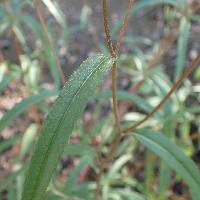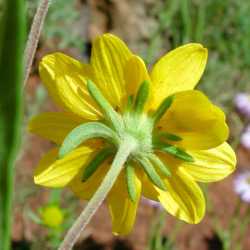|
|
 Leaves Sue Carnahan @http://swbiodiversity.org, Usage Rights: CC BY-NC (Attribution-Non-Commercial) |  Plant Max Licher @http://swbiodiversity.org, Usage Rights: Creative Commons Attribution-ShareAlike (CC BY-SA) |  Phyllaries Max Licher @http://swbiodiversity.org, Usage Rights: Creative Commons Attribution-ShareAlike (CC BY-SA) | | | |
|
Origin:
Native
Life Cycle:
Perennial Similar Species: Heliomeris longifolia
General Desc:
Upright, clump-forming plant, slightly woody base and thin reddish branching stems. Narrow dark yellowish-green leaves have stiff surface hairs. Showy yellow sunflower-like flower heads to 1-1/2 inches wide grow singly or in clusters at the branch tips.
Identification notes: Perennial, slightly woody base; narrow stems are often reddish in color; leaves opposite below, alternate above, narrowly lance-shaped or oblong; showy yellow flower heads with yellow centers at branch tips, visibly hairy phyllaries; achenes not hairy.
Height:
To nearly 3-1/3 feet
Habitat Description: Grasslands, open mountain areas, meadows, rocky slopes, oak/pinyon pinyon/juniper woodlands, ponderosa pine forests, roadsides.
Plant Communities:
Interior Chaparral, Semidesert Grasslands, Pinyon Juniper Woodland, Montane Conifer Forest, Disturbed Areas
Elevation: 4500 - 9500 feet
Color:
Yellow, yellowish-brown, orangish-yellow
Shape:
Daisy or dandelion-like in elongated clusters
Tubular:
N
Flowering Period:
May - Oct
Description:
Flower head has 5 to 14 strap-shaped yellow ray florets (to 3/4 inch) surrounding a flat center of 50 or more tiny yellowish-brown tube-like disc florets which become cone-shaped at maturity. Whorls of hairy leaf-like bracts grow below the flower heads.
Leaf Color:
Dark yellowish-green
Leaf Type:
Simple
Leaf Shape:
Narrow
Leaf Margin:
Smooth
Leaf Attachment:
Alternate and opposite
Leaves Clasp:
N
Hairs:
Leaves and stems
Spines:
N
Leaf Description:
Leaves are 2-1/4 inches long, 3/8 inch wide, opposite on the lower stems and alternate above, with smooth to faintly toothed margins. Leaves have a prominent center vein and are covered with stiff hairs. Lower leaf surfaces are dotted with glands.
Fruit Color: Black or gray-streaked
Fruit Type: Achene
Fruit Notes: Fruit is about 1/8 inch long, dry, 1-seeded, with a smooth surface becoming blotchy with age. It has no tufts of hair (pappus) and doesn't split open to release the seed when ripe. It may be black or gray with long, thin, parallel streaks (gray-striate).
Seed Notes: After the petals drop off, the center of the flower head will darken and develop tight clusters of seed. The seeds are dormant and have a pre-chilling requirement for germination.
|
|